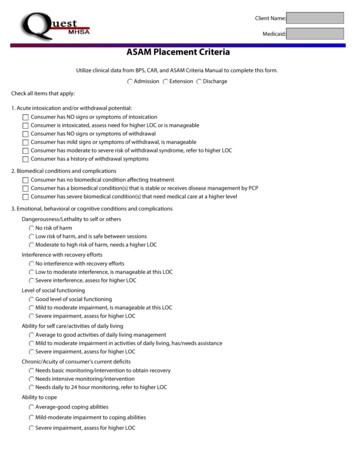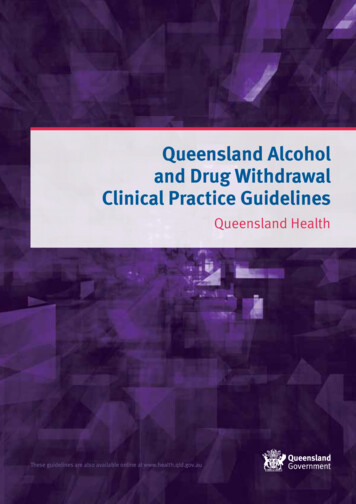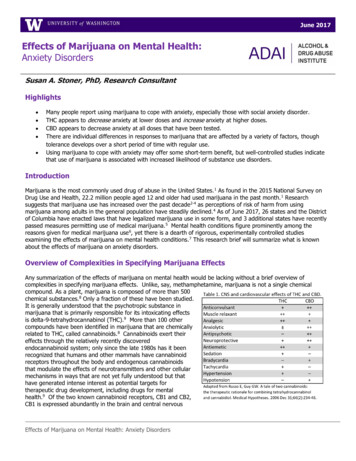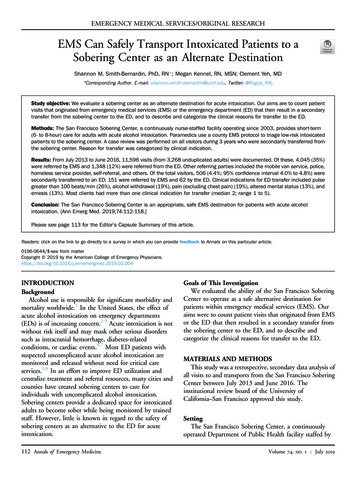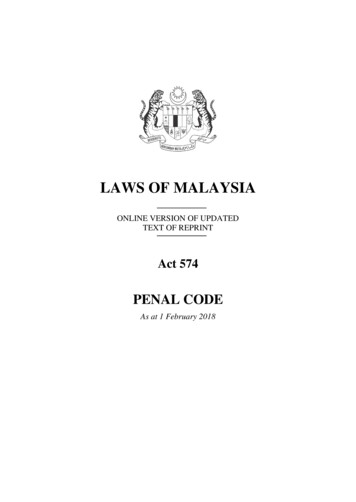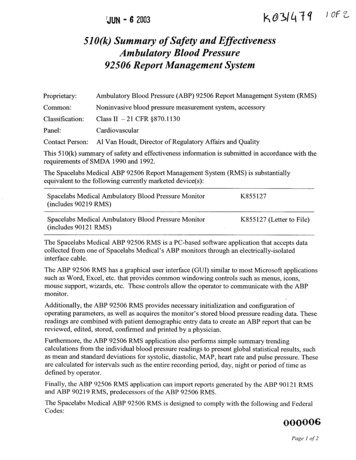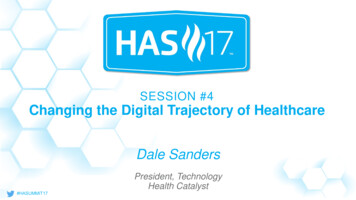
Transcription
Ambulatory Intoxication and Withdrawal Management:A Clinical MonographRevised December 2016 2002-2017 Magellan Health, Inc. 4/17This document is the proprietary information of Magellan Health, Inc. and its affiliates.1
Table of ContentsI.Ambulatory Intoxication and Withdrawal Management . 3II. Evaluation and Assessment of the Substance-Dependent Patient . 9III. Management of the Alcohol/Sedative-Hypnotic-Anxiolytic Withdrawal Syndromein the Ambulatory Setting . 14IV. Management of the Opioid Withdrawal Syndrome in the Ambulatory Setting . 17V. Management of Withdrawal from Other Substances in the Ambulatory Setting. 21Appendices . 25References . 35Appendices Clinical Institute Withdrawal Assessment of Alcohol Scale, Revised (CIWA-Ar)Opiate Withdrawal Signs and SymptomsClinical Opiate Withdrawal ScaleSedative-Hypnotic-Anxiolytic Withdrawal Signs and Symptoms/Alcohol CalculationsAnxiolytics, Sedatives and Hypnotics Classified by Half-LifeNon-Benzodiazepine Sedative-Hypnotics Classified by Half-Life 2002-2017 Magellan Health, Inc. 4/17This document is the proprietary information of Magellan Health, Inc. and its affiliates.2
I.Ambulatory Intoxication and Withdrawal ManagementThe American Society of Addiction Medicine’s clinical guide, The ASAM Criteria: TreatmentCriteria for Addictive, Substance-Related, and Co-Occurring Conditions, Third Edition 2013notes that the process of withdrawal management includes not only “attenuation of thephysiological and psychological features of withdrawal, but also interrupting themomentum of habitual compulsive use in persons with addiction.” The ASAM criteriaindicates that a “successful detox” encounter involves not only acute management ofwithdrawal, but also involves addressing the accompanying addiction process and helpsreduce “readmission for detox” (ASAM, 2013, pp.128-9). In this new third edition of TheASAM Criteria, “detoxification services” are referred to as “withdrawal management,”involving management of intoxication episodes and withdrawal episodes. Intoxicationmanagement and withdrawal management are in contrast with “addiction management”services. With current medication protocols, ASAM notes that all but the most severewithdrawal syndromes can be managed effectively on an ambulatory basis.Description and Levels of IntensityThe ASAM criteria describe five levels of withdrawal management, with a range ofintensities of service. A particular withdrawal management can be provided separatelyfrom other treatment services in the adult criteria. ASAM criteria require that the patientwith co-occurring problems be placed in the level of care appropriate to the most acuteproblem. A range of intensities of services allows patients to receive withdrawalmanagement in the office or in more structured outpatient settings (without intensivenursing monitoring or the use of beds). Patients with significant risk in withdrawal mayrequire intensive medical monitoring and others may need to be monitored in anoutpatient setting before an appropriate determination is made. A more structured service,e.g., a “23-hour observation bed,” in Level 2-WM may be needed for monitoring risk.Withdrawal management programs may include only minimal medical monitoring orsignificant medical monitoring (ASAM, 2013).The five levels of withdrawal management described by ASAM are Level 1-WM AmbulatoryWithdrawal Management without Extended On-Site Monitoring; Level 2-WM AmbulatoryWithdrawal Management with Extended On-Site Monitoring; Level 3.2-WM ClinicallyManaged Residential Withdrawal Management; Level 3.7-WM Medically MonitoredInpatient Withdrawal Management; and Level 4-WM Medically Managed IntensiveInpatient Withdrawal Management. Patients admitted to any level of withdrawalmanagement must meet the diagnostic criteria for substance withdrawal disorder of theDiagnostic and Statistical Manual of Mental Disorders (DSM-5). An exception is for patientsin Level 1-WM or Level 2-WM where alcohol or drug history is inadequate for the diagnosisand not substantiated. In that case, information provided by family members or legalguardians may indicate a high probability of the diagnosis. In this monograph, we arefocusing on the first two levels of withdrawal management services, ambulatory(“outpatient”) services delivered in a variety of settings performed with and withoutextended onsite monitoring. These distinct levels of service and intensity of treatment aredescribed by ASAM as follows: 2002-2017 Magellan Health, Inc. 4/17This document is the proprietary information of Magellan Health, Inc. and its affiliates.3
Level 1-WM: Ambulatory Withdrawal Management without Extended On-SiteMonitoring“Level I-WM Withdrawal Management without Extended On-Site Monitoring is anorganized outpatient service, which may be delivered in an office setting, healthcare oraddiction treatment facility, or in a patient’s home by trained clinicians who providemedically supervised evaluation, withdrawal management, and referral services accordingto a pre-determined schedule. Services are provided in regularly scheduled sessions andshould be delivered under a defined set of policies and procedures or medical protocols”(ASAM, 2013, p. 132). Examples of service delivery include: physician’s office or home healthcare agency. Support systems feature the following: specialized psychological and psychiatricconsultation and supervision for biomedical, emotional, behavioral, and cognitiveproblems; ability to obtain a comprehensive medical history and physicalexamination of patient at admission; availability of affiliated specialty addictiontreatments for additional problems identified through comprehensivebiopsychosocial assessment; appropriate laboratory tests and toxicology testsarranged/conducted; if indicated, 24-hour access to emergency medicalconsultation services; and assistance with transportation services for patientlacking safe transportation. Staffing includes: physicians and nurses who may not need to be present intreatment setting at all times (physician assistants or nurse practitioners in somestates); readily available medical and nursing personnel to evaluate and confirmthat withdrawal management is safe in the less supervised outpatient setting;medical and nursing personnel are not required to be certified as addictionspecialist physicians and nurses, but must be trained and have experience inassessing and managing intoxication and withdrawal management; availablecounselors, psychologists and social workers; and all clinicians assessing andtreating patients are knowledgeable about the biopsychosocial dimensions ofsubstance use disorders, including signs and symptoms of intoxication andwithdrawal as well as appropriate treatment and monitoring of patients withsubstance use disorders. Therapies include: individual assessment, withdrawal management (medication ornon-medical); patient education; non-pharmacological clinical support; involvementof family members/significant others in the withdrawal management process;discharge or transfer planning; and monitoring, assessment, and management ofintoxication and withdrawal signs and symptoms by physicians and/or nurses. Assessment/treatment plan review includes: initial assessment including anaddiction-focused history conducted or reviewed by a physician; a physicalexamination, as part of initial assessment, by physician, physician assistant, or nurse 2002-2017 Magellan Health, Inc. 4/17This document is the proprietary information of Magellan Health, Inc. and its affiliates.4
practitioner; biopsychosocial screening assessment to determine patient’splacement in a level of care; an individualized treatment plan including treatmentgoals and objectives and a plan of how to meet the goals of management of thewithdrawal syndrome; ongoing daily assessment of progress during withdrawalmanagement; transfer/discharge planning; and referrals for counseling, medical,psychiatric and continuing care. Documentation services include: progress notes reflecting treatment planimplementation and patient’s response to treatment; and withdrawal rating scaletables and flow sheets. Patients in Level 1-WM withdrawal management services continue until one of thefollowing conditions is met: resolution of withdrawal signs and symptoms so thatpatient can participate in self-directed recovery or ongoing treatment; withdrawalsigns and symptoms have intensified and failed to respond to treatmentnecessitating patient to be transferred to a more intensive level of withdrawalmanagement service; or patient’s inability to complete withdrawal management atLevel 1-WM (for example, intense craving or insufficient coping skills to preventcontinued use of alcohol, tobacco, and/or other drug use concurrent with thewithdrawal management medication – indicates need for more intensive services).Level 2-WM: Ambulatory Withdrawal Management with Extended Onsite Monitoring“Level 2-WM Withdrawal Management is an organized service, which may be delivered inan office setting, a general healthcare or mental healthcare facility, or an addictiontreatment facility by medical and nursing professionals who provide evaluation,withdrawal management, and referral services. Services are provided in regularlyscheduled sessions and under a defined set of physician-approved policies and proceduresor clinical protocols” (ASAM, 2013, p. 134). An example of service delivery is day hospital service. Support systems feature the following: specialized clinical consultation andsupervision for problems (biomedical, emotional, behavioral, and cognitive); abilityto obtain a comprehensive medical history and physical examination of patient atadmission; access to consultation (psychological and psychiatric); availability ofaffiliated specialty addiction treatments for additional problems identified throughcomprehensive biopsychosocial assessment; appropriate laboratory tests andtoxicology tests arranged/conducted, if indicated; 24-hour access to emergencymedical consultation services; and assistance with transportation services forpatient lacking safe transportation. Staffing includes: physicians and nurses who may not need to be present intreatment setting at all times (physician assistants or nurse practitioners in somestates); medical and nursing personnel readily available to evaluate and confirm 2002-2017 Magellan Health, Inc. 4/17This document is the proprietary information of Magellan Health, Inc. and its affiliates.5
safety of withdrawal management in the less supervised setting; no requirementthat physicians be certified as addiction specialist physicians and no requirementthat nurses be certified as addiction nurses, although training and experience inassessing and managing intoxication and withdrawal states is required; counselors,psychologists, and social workers may provide services through the withdrawalmanagement service or be accessed through affiliation with other entities providingLevel 2 services; clinicians assessing and treating patients are knowledgeable aboutobtaining and interpreting needs of patients and have understanding of thebiopsychosocial dimensions of alcohol and drug addiction, including signs andsymptoms of intoxication and withdrawal as well as appropriate treatment andmonitoring of these conditions. Therapies include: individual assessment, withdrawal management (medication ornon-medical); patient education; non-pharmacological clinical support; involvementof family members/significant others in the withdrawal management process;discharge or transfer planning; and monitoring, assessment, and management ofintoxication and withdrawal signs and symptoms by physicians and/or nurses. Assessment/treatment plan review includes: initial assessment including anaddiction-focused history conducted or reviewed by a physician; a physicalexamination, as part of initial assessment, by physician, physician assistant or nursepractitioner; biopsychosocial screening assessment to determine patient’splacement in a level of care; an individualized treatment plan including treatmentgoals and objectives and a plan of how to meet the goals of management of thewithdrawal syndrome; ongoing daily assessment of progress during withdrawalmanagement; transfer/discharge planning; referrals for counseling, medical,psychiatric and continuing care; and serial medical assessments. Documentation services to include: progress notes reflecting treatment planimplementation and patient’s response to treatment; and withdrawal rating scaletables and flow sheets. Patients continue in Level 2-WM withdrawal management services until one of thefollowing conditions is met: resolution of withdrawal signs and symptoms so thatpatient can be safely managed at a less intensive level or care; withdrawal signs andsymptoms have failed to respond to treatment (standardized scoring systems, e.g.,CIWA-Ar, have confirmed that signs and symptoms have intensified) such thattransfer to a more intensive level of withdrawal management service is needed; orpatient’s inability to complete withdrawal management at Level 2-WM (for example,intense craving or insufficient coping skills to prevent continued use of alcohol,tobacco, and/or other drug use concurrent with the withdrawal managementmedication) indicates need for more intensive services. 2002-2017 Magellan Health, Inc. 4/17This document is the proprietary information of Magellan Health, Inc. and its affiliates.6
Intensive Outpatient/Partial Hospitalization ServicesThere are 10 adult levels of care placements in the in the treatment of addictive, substancerelated, and co-occurring conditions. Levels of care provided in the ambulatory setting are:Level 1 (Outpatient Services), Level 2.1 (Intensive Outpatient Services), and Level 2.5(Partial Hospitalization Services). Level 2.1 Intensive Outpatient Program (IOP)There are nine to nineteen hours of structured programming per week (for adults)during the day or evening, and/or weekend. Patients placed in these services meetthe diagnostic criteria for a substance use and/or other addictive disorder asdefined in the DSM-5. Appropriately credentialed addiction treatment professionals,e.g., counselors, psychologists, social workers, and addiction-credentialedphysicians, staff the IOP. Physicians should have experience in addiction medicine oraddiction psychiatry and have specialty training. Staff should also be cross-trainedto understand signs and symptoms of mental disorders. Intensive outpatientservices are provided in settings meeting state licensure or certification criteria. Thepatients’ withdrawal needs are safely managed in this setting. These services mayinclude counseling (individual and group), medication management, family therapy,educational, occupational and recreational therapy, motivational interviewing,enhancement, and engagement strategies. Programs include individualbiopsychosocial assessment, physical examination if needed, an individualizedtreatment plan, and monitoring (including biomarkers and/or toxicology testing). Aplanned program of therapies is offered to patients with co-occurring addictive andmental disorders (ASAM, 2013). Level 2.5 Partial Hospitalization Program (PHS)These “day treatments” feature 20 or more hours of intensive programming perweek. Appropriately credentialed addiction treatment professionals, e.g.,counselors, psychologists, social workers, and addiction-credentialed physicians,staff the PHS. Physicians should have experience in addiction medicine or addictionpsychiatry and have specialty training. Staff must be able to interpret informationrelated to the patient’s biopsychosocial needs. They should also be cross-trained tounderstand signs and symptoms of mental disorders. The partial hospitalizationprograms provide access to psychiatric, medical, and laboratory services to meetneeds which warrant daily monitoring or management. The day or partial hospitalprograms are offered in settings meeting state licensure or certification criteria. Thepatients’ withdrawal needs can be safely managed in this setting. Services includecounseling (individual and group), medication management, family therapy,educational, occupational and recreational therapy, motivational interviewing,enhancement, and engagement strategies. Programs include individualbiopsychosocial assessment, physical examination if needed, an individualizedtreatment plan, and monitoring (including biomarkers and/or toxicology testing). Aplanned program of therapies is offered to patients with co-occurring addictive andmental disorders. The difference between IOP and PHS is in the intensity of clinicalservices directly available. Intensive outpatient programs have less capacity than 2002-2017 Magellan Health, Inc. 4/17This document is the proprietary information of Magellan Health, Inc. and its affiliates.7
partial hospitalization programs in effectively treating patients with substantialunstable medical and psychiatric programs (ASAM, 2013).Parameters Influencing Level of Care PlacementAccording to ASAM, the level of care placement is not the initial step in the treatmentprocess. Before considering a level of care placement, practitioners of the ASAM criteriadetermine priority dimensions, diagnoses, and dose and intensities through acomprehensive assessment. Assessment information comes from six admission criteria.They include Dimension 1: Acute Intoxication and/or Withdrawal Potential; Dimension 2:Biomedical Conditions and Complications; Dimension 3: Emotional, Behavioral, orCognitive Conditions and Complications; Dimension 4: Readiness to Change; Dimension 5:Relapse, Continued Use, or Continued Problem Potential; and Dimension 6:Recovery/Living Environment (ASAM, 2013). Some of the parameters that the providerand clinician reviewer should consider when making decisions about level of care are: Prior history of withdrawal complications. If there is a prior history ofsignificant withdrawal complications, such as generalized seizures or deliriumtremens, it is more likely that this individual will require intensive medical andnursing interventions on a 24 hour/day basis or in an experienced ambulatorywithdrawal management facility. Co-occurring medical conditions. If an individual has a chronic stable medicalcondition that the withdrawal management process would significantly exacerbate,more intensive medical and nursing supervision and intervention are in order.Additionally, when there is a history of an unstable medical problem (e.g.,uncontrolled insulin-dependent diabetes, uncontrolled hypertension), or there isserious organ damage from the substance (e.g., acute alcoholic pancreatitis, hepaticdecompensation), then more intensive medical and nursing supervision isindicated. Co-occurring behavioral conditions. Patients who present with significantpsychiatric co-occurring conditions, with or without significant withdrawalmanagement needs, present unique complexities concerning decisions of locationof treatment. If the patient has a significant psychiatric disorder such as majordepression with suicidal ideation, combined with minimal withdrawalmanagement needs, then the location for treatment would most likely be apsychiatric inpatient setting that could also manage the substance withdrawalmanagement. On the other hand, if the same patient presented with a dangerouslevel of withdrawal needing intensive medical (non-psychiatric) supervision, thenthe likely location would be a medical (non-psychiatric) inpatient setting that couldaccommodate suicidal precautions. Social support system. Outpatient withdrawal management is recommendedwhen the patient has a support person(s) capable of assuring that he/she will havetransportation to the program. In addition, the support person(s) should not beactively involved in substance abuse. 2002-2017 Magellan Health, Inc. 4/17This document is the proprietary information of Magellan Health, Inc. and its affiliates.8
Patient’s level of motivation and cooperation. For patients to effectivelyparticipate in outpatient withdrawal management programs, they must expressand exhibit a willingness to adhere to program requirements and expectations. Polysubstance dependence. The patient abusing more than one substancepresents certain challenges in determining the most appropriate level of care forthe withdrawal management process. One of the more important considerations isthe actual pattern of substance use preceding entry into the withdrawalmanagement process. Individuals who are alcohol dependent but only sporadicallyuse benzodiazepines may not have a dependence on the benzodiazepine, and hencemay be safely managed on an ambulatory basis, depending on the otherparameters. On the other hand, individuals actively dependent on alcohol andbenzodiazepines will require an intensive level of medical and nursing supervisionand intervention for withdrawal management and, as a general rule, may requirean inpatient level of care.II. Evaluation and Assessment of the Substance-Dependent PatientPurposeThis monograph provides updated information on medical withdrawal management ofpatients whose substance use disorder has progressed to the point that physicaldependence has developed. The goal is to assist providers and Magellan clinician reviewersin the delivery of high quality care for these patients.Treatment PhilosophyThe primary objective of medical withdrawal management is to “break the cycle” ofsubstance use, providing the patient with a medically safe and comfortable withdrawalfrom the substance of dependence in the least restrictive setting possible.DefinitionsThe Diagnostic and Statistical Manual of Mental Disorders (DSM-5), published in 2013,includes several changes to addictions, substance-related disorders, and alcohol. Keychanges include the addition of gambling disorder as a behavioral addiction, and thecombination of substance abuse and substance dependence into single substance usedisorders, further divided into mild, moderate, and severe subtypes based on the numberof criteria endorsed. Accompanying the diagnostic criteria for substance use disorder arecriteria for intoxication, withdrawal, substance-induced disorders, and unspecifiedsubstance-related disorders, where relevant. Diagnostic criteria for substance use disorderfit within overall groupings: impaired control, social impairment, risky use, andpharmacological criteria. Two or more of the 11 criteria must be met within a 12-monthperiod for a diagnosis of a substance use disorder in DSM-5; one or more criteria wererequired for diagnosis of substance abuse and three or more required for diagnosis ofsubstance dependence in DSM-IV. A new criterion, i.e., “craving or a strong desire or urge touse a substance,” has been added, and the “recurrent legal problems” criterion has beenremoved from DSM-5. New specifiers include “in a controlled environment” and “on 2002-2017 Magellan Health, Inc. 4/17This document is the proprietary information of Magellan Health, Inc. and its affiliates.9
maintenance therapy.” Other new disorders in DSM-5 are cannabis withdrawal and caffeinewithdrawal (American Psychiatric Association, 2013). Working definitions of terms used inthis monograph include the following:1.Substance Use Disorder. Features include a cluster of cognitive, behavioral, andphysiological symptoms indicating that, despite substance related problems, theindividual continues to use the substance. A characteristic of substance use disorder isan underlying change in brain circuitry.2.Substance Intoxication. The predominant feature is a “reversible substance-specificsyndrome due to the recent ingestion of a substance,” e.g., disturbances of perception,wakefulness, attention, thinking, psychomotor behavior, judgment, and interpersonalbehavior.3.Substance Withdrawal. Essential feature is a “substance-specific problematicbehavioral change, with physiological and cognitive concomitants, that is due to thecessation of, or reduction in, heavy and prolonged substance use.”4.Medical Withdrawal Management. Medical withdrawal management is the processby which an individual with a substance disorder is withdrawn from a substance usingmedical interventions and supervision. This process most commonly occurs by thegradual administration of decreasing doses (tapering administration) of an agentthat is cross-tolerant (a substance of the same class that can be substituted to preventwithdrawal) to the substance used, or by symptom-targeted administration of across-tolerant agent (i.e., the agent is given only when signs of withdrawalmanagement are present - see CIWA-Ar, below). The primary objective of medicalwithdrawal management is to provide the patient with a medically safe andcomfortable withdrawal from the substance in the least-intensive, least-restrictivesetting possible, while at the same time optimizing the patient’s acceptance ofrehabilitation.5.Delirium Tremens (a.k.a. “DTs” or Alcohol Withdrawal Delirium). A syndromecharacterized by the onset of clouding of consciousness, difficulty sustaining attention,disorientation to surroundings and situation, agitation, excessive sweating andautonomic hyperactivity (vital sign instability with tachycardia, elevated bloodpressure, and low grade fever) occurring upon the abrupt discontinuation of alcohol.In addition, one may experience hallucinations of a visual and/or tactile nature such asformication (‘ants crawling all over me’). The onset of the DTs typically peaks withintwo days post cessation of alcohol and abates within four to five days. In unusualcases, the onset may not occur for three to five days post cessation and last up to 10days. While death can occur from severe dehydration due to excessive sweating, thisdoes not occur as frequently as in the past due to modernized treatment facilities.6.Alcoholic Hallucinosis. Alcoholic hallucinosis is the occurrence of auditory, visual,and/or tactile hallucinations in a clear sensorium.7.Blood Alcohol Level (BAL) or Blood Alcohol Content (BAC). A quantitative measureof the content of alcohol in the blood as measured in either mg/dl or mg percent (100mg/dl equals 0.1 mg percent, the limit of legal intoxication in many states). BAL can beused to assess an individual’s level of tolerance to alcohol and predict the relative 2002-2017 Magellan Health, Inc. 4/17This document is the proprietary information of Magellan Health, Inc. and its affiliates.10
severity of subsequent withdrawal. For example, an individual with a BAL of 300mg/dl (0.3 mg percent) who doesn’t have slurred speech or a gait disturbance, has ahigh degree of tolerance and can be expected to experience significant withdrawalsymptomatology (400 mg/dl, or 0.4 mg percent would put many into a coma). As arule of thumb, use of a quart of vodka, a gallon of wine, or a case of beer per day, orfindings of a BAL over 150 mg/dl (0.15 mg percent) without external evidence ofintoxication, demonstrates tolerance and are likely indicators of alcoholism.ScopeAccording to the 2015 National Survey on Drug Use and Health (NSDUH), an estimated 20.8million people (or 7.8 percent of the population) aged 12 or older had a past-yearsubstance use disorder based on criteria specified in the DSM-5. Out of those with an SUD,15.7 million people (or 75.6%) had a past-year alcohol use disorder, and 7.7 million(37.2%) had a past-year illicit drug use disorder. Also, 2.7 million people aged 12 or olderhad both and illicit drug use disorder and an alcohol disorder in the past year. Of the 7.7million with a past-year SUD related to their use of illicit drugs, almost 52% had a past-yeardisorder related to marijuana use and almost 26% had a past-year disorder related tomisuse of prescription pain relievers. Smaller percentages were related to the use ofcocaine or heroin (SAMHSA, 2016).The Surgeon General’s Report on Alcohol, Drugs, and Health, Facing Addiction in America,reports that the estimate of the cost of substance use disorders, alcohol misuse, illicit druguse, and misuse of prescription medications is more than 400 billion in the United States(U.S. Department of Health & Human Services, 2016). Related costs include healthcareexpenses, law enforcement, motor vehicle crashes, and lost workplace productivity. Bingedrinking accounts for approximately 75% of the costs associated with alcohol use, of whichabout 40% of these costs are borne by taxpayers (paid by government). The SurgeonGeneral’s Report also discusses direct and indirect health and consequences for individuals,e.g., “changes in mood and basic body functions, such as heart rate or blood pressure, tooverdose and death” (U.S. Department of Health & Human Services, 2016, p. 1-12). Serious,and sometimes lethal, problems related to substance misuse include driving under theinfluence; overdose deaths; and intimate partner violence, sexual assault, and rape.The DSM-5 identifies 10 substance classes (not fully distinct). More information has beenpublished on withdrawal syndromes for other classes of substances – e.g., anabolicandrogenic steroids (AAS) and certain club drugs (Kishner, 2008; Talih et al., 2007;Gahlinger, 2004; TIP 45, 2006). However, only the drugs/classes bolded below areassociated with withdrawal phenomena: Alcohol Caffeine Cannabis Hallucinogens (phencyclidine and other hallucinogens) 2002-2017 Magellan Health, Inc. 4/17This document is the p
2002-2017 Magellan Health, Inc. 4/17 This document is the proprietary information of Magellan Health, Inc. and its affiliates. 2 Table of Contents
